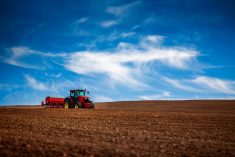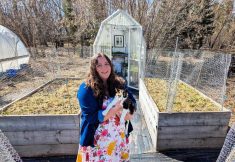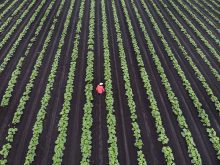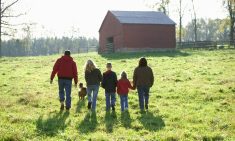At a time when other farmers lay awake wondering how they can manage to acquire more land, the husband and wife team of John Cote and Barb Stefanyshyn-Cote have downsized dramatically. They’ve gone from farming 5,000 acres to farming 80 acres.
And they couldn’t be happier.
The Cotes grow and sell flowers, adding up to some 80 varieties on five acres. They’ve got annuals. They’ve got perennials. They’ve got bulbs and corms and ornamental grains and grasses.
Looking further down the road, they’ve also planted four acres to haskap and six to raspberries, and they’re about 18 months away from opening an on-farm distillery and a retail store.
Read Also

Farmland values: assumptions and realities
Where farmland values are headed and what decisions farmers should make
In other words, they’ve traded one version of earning their livelihood from the land to an utterly different version. But it still starts with the land.
Selling the family farm
Getting out of big farming was a mutual decision, says Barb. “One day my husband came to me and said, ‘You know I really don’t like grain farming.’ And I said, ‘I know.’”
Remembering that conversation, and why he had made that statement and why he felt that way, John says, “It was probably because I had done it long enough. There wasn’t as much of a challenge left. You know, when you first start out, when you’re young, you have to do all this learning and you have to be really into it. And that’s very enjoyable.”
But he knew a time had come when he needed to take on new challenges and learn new things. At the same time, he and Barb both wanted their four children to have the opportunities a bigger centre could offer. They wanted to be closer to services such as hospitals and an airport. And they wanted to get into direct marketing.
In 2010, the Cotes made the decision to sell the family farm near Leask, an hour north of Saskatoon.
The farm had been in John’s family for three generations.
“A lot of people had an emotional stake in it, not financial but emotional,” says Barb. “There were questions. But we received everyone’s approval. Everyone understood our position. This made it far easier for us.”
A new beginning
The Cotes bought the farm where they now live and work near Saskatoon in August of 2010. Once they’d acquired it, the question was — now, what do we do with it?
The first year, 2011, they cleaned and mowed and summer fallowed. The second year they installed drip irrigation on the entire farm and they seeded test plots with corn, melons, and other crops including flowers to see what would grow well. They found that their well-drained, somewhat sandy soil would grow lots of different plants without too many problems.
The more important question became: What would they sell?
Vegetables were a definite possibility. People like buying fresh, local vegetables. But there was something about flowers. Selling flowers just isn’t the same. People don’t apply as tough a mindset to the purchase of flowers as they do to the purchase of vegetables, John explains. When buying vegetables, the niggling thought is always in the back of their mind that they could get this vegetable cheaper elsewhere.
“With flowers, you don’t get that,” John says. “It seems to come out of a different budget.”
In 2012, the Cotes grew vegetables and flowers. In 2013, they grew mostly flowers and a few vegetables. In 2014, they’ll grow only flowers, which works out well because farming flowers is what Barb really, really likes.
“When we were grain farming, I was kind of the head grain farmer guy, and now that we’ve done this, Barb has definitely taken the lead and I’m in more of a supporting role,” John says.
In spite of being absolutely in her element, it’s been a steep learning curve, Barb says. “In grain farming, if you have difficulties, if you have weeds or disease or questions, the answer can be found. The information is there. Everybody’s been growing wheat and barley and canola for years. There’s information on every possible weed or disease, and if there isn’t, somebody’s working on it. There’s a huge network to rely on.”
Not so with the myriad of blooms on her farm. For more than 80 varieties she needs to know: What type of soil do they like? What are the best nutritional recommendations? What’s the best cutting time? How long can they be stored?
Mentors, ag extension departments, trial-and-error — she has learned from them all, and she has discovered a wealth of home gardeners with tons of experience they’re happy to share. One of those contacts, a gardener from Prince Edward Island, recommended Barb take out a membership in the Association of Specialty Cut Flowers, based in the U.S. She did, and she also visits other gardens and learning events whenever she can. Last fall she want to a flower grower business school in Rhode Island.
Some general farming skills have been transferable. Knowing about fertilizers, pesticides and herbicides, and being able to diagnose some of the diseases, all come in handy. The equipment, including a tractor, sprayer, and back-pack sprayer, is all smaller but still similar to the machinery they used on their grain farm.
There’s a lot more walking, though. And it’s a lot more hands-on. Barb says she’s in better shape physically than she’s been in a long time. “Five acres doesn’t sound like much but when you’re on the end of a hoe, five acres is pretty big.”
The new skills they’ve had to acquire are more in specifics, she says. They’ve never grown haskaps before; not many people in Canada have. “We planted it in a raised mulch bed. Was that good? We’ll know within a year and a half.”
Building on what they’ve learned

Some of the skills the Cotes have developed in their transition to flowers will add to their success as they continue to diversify.
Selling direct means developing relationships with their customers, John says. Relationships are about taking the time to talk to customers and answer their questions, keeping in mind that sometimes these people haven’t been on a farm for a very long time and may possess some outdated ideas about the way things happen.
The Cotes have also developed the ability to better manage change, to always have a plan B in the background, including financing, so they know what they’re going to do if the original plan doesn’t work.
One serendipitous discovery is the realization of what is possible. “The potential for growth is much larger than in grain farming,” John says. “In this, if you can think of it and you have the energy to do it, you can make a very nice little business if you have good location.”
Their location, on Saskatoon’s Valley Road alongside several greenhouses and a couple of berry farms, five minutes from the city, was no accident. Land prices there are considerably higher per acre than they were able to realize from their farm at Leask, but they knew that for smaller-scale farming, location was pivotal.
A year of flowers
A typical year on Tierra Del Sol, as John and Barb have named their flower farm, looks both similar and different to a year on a more conventional Saskatchewan farm.
In January, Barb shops for seed. The Cotes buy wholesale, but like any gardener Barb spends a lot of time poring over seed catalogues. Like any farmer, too, she keeps careful records. What’s selling? What’s not selling? Explains Barb: “The first go-round is based on very solid basis of, ‘Yes, we need more of this, no, we don’t need that.’ The second go-round is more based on whim.”
Also in January, they attended a bridal show to let people know about Tierra Del Sol for wedding flowers and year-round flower needs. It’s important to keep up with trends in the wedding industry, which is another factor to keep in mind when ordering seed and planning plots.
Winter is a time to work on marketing strategies. They revamp the website and freshen up their social media presence. They visit florists, event planners and others who might need flowers on a large-scale basis. They redesign their farmers market booth.
And, like conventional farmers, they do repairs, clean out storage areas, and get ready for the season ahead.
As these tasks are completed, they move into the spring prep season, preparing the soil and laying out the seed beds in advance of the actual planting.
Almost all of their plants are grown from seed, placed directly in the ground. Plastic mulch keeps moisture in and weeds out. Barb will grow some bedding plants to lengthen the season but the majority are placed one seed at a time, and the flowers will be ready on time. “It’s surprising what our long days do,” Barb says. “Zones four, five, and six may have nicer weather but they don’t have the growing days that we have.”
Appropriately, Tierra Del Sol is Spanish for “Land of the Sun.” Saskatchewan receives 320 days of sunshine per year.
From the Manitoba Co-operator website: An ode to the Prairie garden
When market season starts, the Cotes have their booth set up at the Saskatoon Farmers Market and are ready for business at 8 a.m. That means leaving the house no later than 6:30 a.m. Last year they attended the market four days a week. Their two youngest teenage children help out at the market, and they employ five other workers on a seasonal basis.
After the market day is done, usually between 2 and 4 p.m., they drop off unsold flowers at women’s shelters and nursing homes. It’s a way of giving back, and a nice way to end the day, Barb says. But the day isn’t really over. Flowers must be cut for the next day’s market. It takes two to three people two to three hours to pick and prepare the flowers for a day at the market. Flowers are sold by the stem, by the bundle or in arrangements.
Volunteers come to the farm to pick flowers in exchange for bouquets to take home. “That one really blows grain farmers away,” Barb says with a grin. “That comes down to being in direct contact with the customer. I’ve received more hugs from strangers at the farmers market than I ever did hauling grain!”
The Cotes also sell to florists and from the farm gate. One of the things that sets Tierra Del Sol apart from other florists is that customers can choose to pick their own flowers, an option that’s proven popular with brides.
As the growing season winds down, harvesting begins. They save seed from varieties they’ve been particularly impressed with, and they also save and store bulbs and corms. For now, they store their bulbs and corms in coolers but when the retail shop is completed it will have a space for this purpose.
Their first ever pumpkin festival was a success last fall, attracting over 1,200 people over a two-day period. Events included a type of bowling using pumpkins as balls, a bale maze, and a game of angry pumpkins.
In the fall Barb attended grower school and thought about a special Christmas event possibly in the future. Fall is also a time for reflection and evaluation and an opportunity to tackle some of the big projects around the farm including finishing their gate signage.
In the orchard, meanwhile, the raspberries will be going into production in 2014 and the haskaps in 2015. The building for the distillery and retail shop is up and work has begun on the interior.
At the same time, the Cotes have begun making their way through the paperwork required to set up a distillery. When they’re up and running, they’ll produce whiskey, vodka, gin, and flavoured liqueurs. They’ll grow the majority of their inputs. “What we would like is to have people come out and help seed the wheat or plant the barley and later help harvest it, put it in the still, and bottle it off,” says Barb. They plan to be in production within 18 months.
For those who might be thinking it’s time for a change or to get smaller or to try a new way of farming, John Cote offers this advice:
“People who are out there doing the same thing for 25 years always say, ‘You know, I wish I would have done whatever, but I’m 45, it’s no time to do it.’ And my only advice is that it’s easier to do it at 45 than it is at 65.”
“Bring your loved ones along,” John adds. “You have to bring everybody along.”
I was kind of the head grain farming guy,” John says. Now, roles have been re-examined















